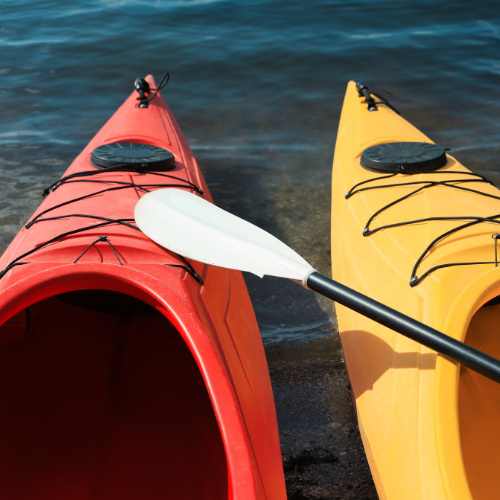#Collborative post
Kayaking is a fantastic way for families to bond while exploring the great outdoors. It’s not only fun but also a great way to teach kids about nature, water safety, and the importance of physical activity. In this comprehensive guide, we’ll cover everything you need to know about kids kayaking trips—from choosing the right gear to planning your adventure and ensuring everyone’s safety. Whether you’re a seasoned kayaker or a beginner, this guide will help you create unforgettable memories on the water.
Benefits of Kayaking for Kids
Kayaking offers numerous benefits for children, including physical health improvements, mental well-being, and educational opportunities.
Physical Health
Kayaking is a full-body workout that enhances cardiovascular health, strength, and flexibility. Paddling works the arms, shoulders, and core muscles, while balancing in the kayak helps improve coordination and stability.
Mental Well-being
Being on the water has a calming effect that can reduce stress and anxiety. The rhythmic motion of paddling can be meditative, helping kids relax and enjoy the moment.
Education
Kayaking trips can be educational, teaching kids about the environment, water ecosystems, and wildlife. It’s an excellent opportunity to learn about nature and develop a deeper appreciation for the outdoors.

Choosing the Right Kayak
Selecting the right kayak is crucial for a successful and enjoyable trip.
Types of Kayaks
There are several types of kayaks to consider:
- Sit-on-top Kayaks: These are stable and easy to get in and out of, making them ideal for beginners and kids.
- Sit-in Kayaks: These provide more control and are better for longer trips and colder conditions.
- Inflatable Kayaks: Lightweight and portable, these are great for families with limited storage space.
Kid-friendly Features
When choosing a kayak for kids, look for:
- Lightweight design: Easier for kids to handle.
- Comfortable seating: Ensure there is adequate support and cushioning.
- Safety features: Built-in flotation devices and stable hull design.
Essential Gear for Kids
Having the right gear ensures safety and comfort on the water.
Life Jackets
A properly fitting life jacket is essential for every child. Look for jackets specifically designed for kids with a snug fit and comfortable straps.
Paddles
Kid-sized paddles are lighter and easier to manage. Adjustable paddles can grow with your child.
Safety Equipment
Pack a basic safety kit including a whistle, first aid kit, sunscreen, and plenty of water. Consider a dry bag for keeping essentials like snacks and electronics dry.

Preparing for the Trip
Proper preparation can make or break your kayaking adventure.
Planning
Choose a suitable location based on your family’s experience level and preferences. Consider the length of the trip, water conditions, and accessibility.
Packing
Pack light but ensure you have all essentials, including clothing suitable for the weather, food, water, and safety gear.
Weather Considerations
Always check the weather forecast before heading out. Avoid kayaking in extreme weather conditions and be prepared for sudden changes.
Top Destinations for Kids Kayaking
Finding the perfect spot can enhance the experience for your kids.
Lakes
Lakes are often calm and safe for beginners. Consider destinations like Lake Tahoe or the Great Lakes.
Rivers
For a bit more adventure, try family-friendly rivers with gentle currents. The Colorado River and the Delaware River are excellent choices.
Coastal Areas
Kayaking along the coast offers beautiful scenery and the chance to see marine wildlife. Destinations like the Florida Keys and California’s coastline are ideal.
Safety Tips for Kids
Safety should always be the top priority on any kayaking trip.
Supervision
Never let kids kayak alone. Ensure there is always adult supervision and preferably in pairs or groups.
Rules
Establish clear rules before the trip, such as staying close to the group, wearing life jackets at all times, and not standing up in the kayak.
Emergency Procedures
Teach kids what to do in case of an emergency, such as capsizing or getting separated. Practice these procedures in a safe environment.
Teaching Kids to Kayak
Learning to kayak can be a fun and rewarding experience for kids.
Basics
Start with the basics, such as how to hold the paddle, basic strokes, and how to get in and out of the kayak.
Techniques
Teach proper paddling techniques to help them move efficiently and conserve energy. Demonstrate how to steer and stop the kayak.
Building Confidence
Encourage kids and praise their efforts to build their confidence. Start with short trips and gradually increase the difficulty as they improve.
Fun Games and Activities
Keep the adventure exciting with games and activities.
Scavenger Hunts
Create a list of items for kids to find while kayaking, such as specific types of plants, animals, or landmarks.
Water Games
Play games like water tag or races to make the trip more engaging.
Wildlife Spotting
Bring binoculars and a guidebook to identify birds and other wildlife. It’s a fun way to learn about the local ecosystem.
Best Time to Go Kayaking
Choosing the right time can enhance your experience.
Seasonal Considerations
Spring and summer are generally the best seasons for kayaking due to warmer weather and calmer waters.
Weather Patterns
Avoid kayaking during storms or in extreme heat. Early mornings or late afternoons are often the best times to avoid crowds and enjoy peaceful waters.
Kayaking Etiquette
Respecting nature and others ensures everyone has a great time.
Respecting Nature
Follow the “Leave No Trace” principles. Don’t disturb wildlife and take all trash with you.
Other Kayakers
Be courteous to other kayakers. Yield to those with less maneuverability and communicate clearly.
Local Rules
Always follow local regulations and guidelines for watercraft and outdoor activities.
Handling Challenges
Be prepared to face and overcome challenges on your trip.
Dealing with Fear
If a child is scared, stay calm and provide reassurance. Take breaks and encourage them gently.
Capsizing
Teach kids how to stay calm and right their kayak. Practice in a safe environment before going on the trip.
Tiredness
Plan regular breaks to rest and hydrate. Ensure kids aren’t overexerting themselves.
Health and Fitness Tips
Keeping fit and healthy enhances the kayaking experience.
Exercises
Strengthening exercises for the arms, shoulders, and core can improve paddling efficiency.
Hydration
Ensure everyone stays hydrated, especially on hot days. Bring plenty of water and encourage regular sips.
Rest
Get plenty of rest before and after the trip to recover and avoid fatigue.
Environmental Awareness
Teaching kids to respect the environment is crucial.
Leave No Trace
Educate kids on the importance of leaving nature as they found it. Pick up all trash and avoid damaging plants and wildlife habitats.
Wildlife Respect
Observe animals from a distance and never feed them. Teach kids to respect their space and natural behavior.
Budget-friendly Kayaking Trips
Kayaking doesn’t have to be expensive.
Affordable Destinations
Look for local lakes and rivers that don’t require expensive permits or fees. National parks often have affordable entry fees.
Saving Tips
Rent equipment instead of buying it, or look for used gear. Plan day trips to save on accommodation costs.
Camping and Kayaking
Combining camping and kayaking can make for a fantastic adventure.
Combining Activities
Find locations where you can kayak to your campsite. It adds an extra layer of excitement to the trip.
Best Spots
Look for national parks or reserves with both kayaking and camping facilities. Ensure the campsite is accessible by water.
Tips
Pack lightweight, waterproof camping gear. Plan your route and make reservations in advance.
Kayaking Clubs and Communities
Joining a club can enhance your kayaking experience.
Finding Groups
Look for local kayaking clubs or online communities. They often organize trips and provide valuable advice.
Benefits
Clubs offer opportunities to learn from experienced kayakers, access to group trips, and a sense of community.
Events
Participate in events and competitions to improve skills and meet other kayaking enthusiasts.
Insurance
Insurance plays a crucial role in kayaking, offering peace of mind and financial protection against unexpected events on the water. Whether you’re a casual kayaker or an avid adventurer, having the right insurance can safeguard you from potential risks such as equipment damage, accidents, and medical emergencies.
Certain boat insurance can cover your kayak and gear, while personal liability insurance protects you from legal and medical expenses if an accident occurs. By ensuring you’re adequately covered, you can enjoy your kayaking adventures with confidence, knowing that you have financial support in case of unforeseen circumstances.


